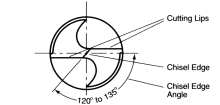
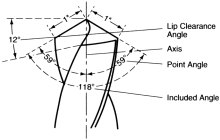
Most drill troubles arise from inaccurate pointing. Correct drill pointing will to a great extent eliminate drill breakage and inaccurate holes. Drill pointing should be varied depending upon the materials to be drilled, but for general use, drills leave the factory sharpened to a 59° point angle (118° included angle), 9° - 15° clearance angle and with a chisel edge angle of 120° to 135°.
Since most operators do not have the skill required for good hand pointing, the use of standard drill pointing machines is highly recommended. Drills are machine pointed at the factory to a 118° angle to insure a correct and uniform point angle, equal cutting lips and correct chisel edge angle.
The point angle of a twist drill is the angle made by the cutting lip and the axis of the drill. For general purpose drilling a point angle of 59° (118° included angle) is recommended. The point angle may vary somewhat, one way or the other, but the variation should be uniform in both cutting lips. A twist drill point grinding gauge should be used for checking the point angle of both cutting lips.
CAUTION: When high speed steel drills are sharpened by dry grinding, care should be exercised to prevent overheating. If the drill does get too hot, do not cool in water, but let it cool by itself in air. Sudden cooling of high speed steel drills in water or other cooling mediums will usually produce grinding checks, which may result in chipping of the cutting lips or breaking of the drill point.
CUTTING LIPSThe cutting lips must be of equal length. Even though the point angle is equal on both sides, if the cutting lips are not equal in length the chisel edge will not be centered, and the drill will cut oversize. A scale should be used to check the lengths of the cutting lips. |
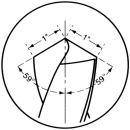 |
RIGHTCorrectly ground lips have the same angle to the axis of the drill and are of equal length. An accurate hole will be produced with this point. |
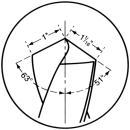 |
WRONGUnequal lip lengths produce oversize holes. Unequal lip angles place most of the cutting on one lip and point dulls faster. |
LIP CLEARANCESufficient clearance behind the cutting lips must be provided so that the cutting edges can enter the work. Usually 9° to 15° lip clearance is sufficient for average work if the point is ground with the proper angle and the proper clearance, but without the proper contour back of the cutting edges, the cutting lip will be weakened. |
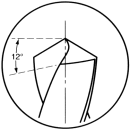 |
RIGHTA point with proper lip clearance permits the drill to cut freely. The cutting lip is sufficiently supported to prevent excessive dulling or chipping. |
 |
WRONGToo much clearance (over 15°) will cause cutting lips to break down. Insufficient clearance (under 9°) requires excess feed pressure, causes drill to split up the web. |

